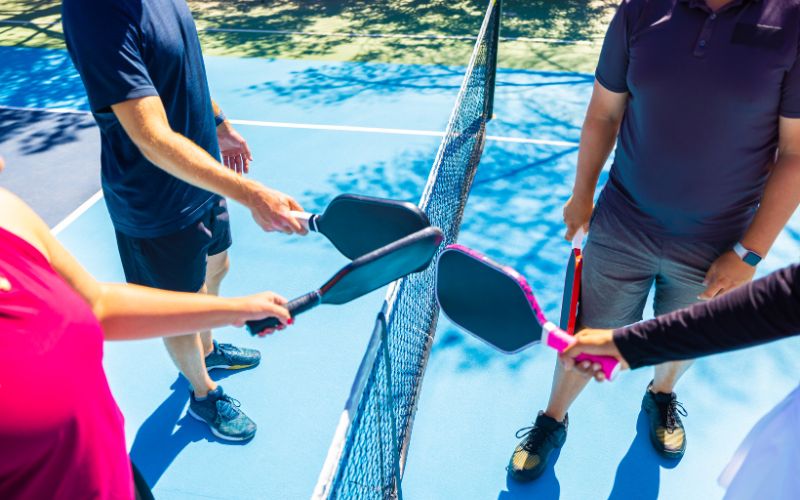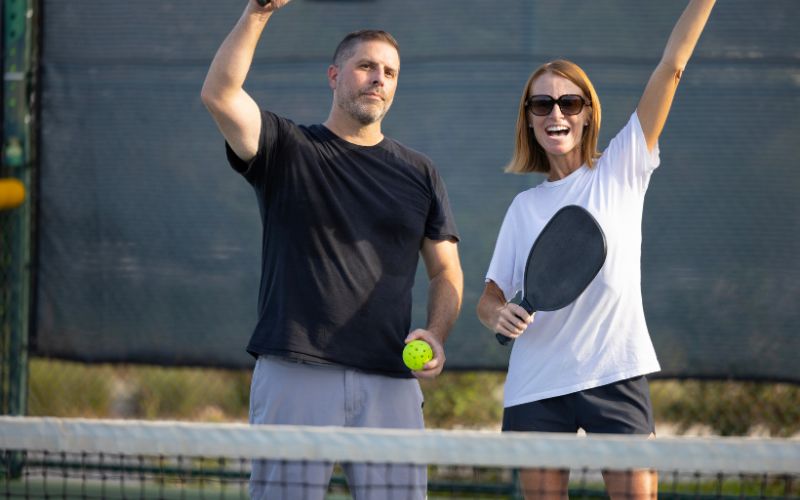In the realm of fitness and sports, understanding the calories burned during various activities is essential for those seeking to maintain a healthy lifestyle or shed some extra pounds. Pickleball, a sport rapidly gaining popularity worldwide, offers a fun and engaging way to stay active while enjoying time with friends and family. In this article, we delve into the specifics of calories burned playing pickleball doubles, exploring its impact on weight loss, cardiovascular health, and overall well-being.
Understanding Pickleball: A Brief Overview
Pickleball, often described as a combination of tennis, badminton, and ping pong, is played on a pickleball court with a net and paddles. The game can be played in singles or doubles format, with players volleying a wiffle ball back and forth over the net. It’s known for its accessibility to players of all ages and skill levels, making it a favorite among recreational athletes and seasoned competitors alike.
The Rise of Pickleball: A Growing Trend
In recent years, pickleball has experienced a surge in popularity, attracting players from diverse backgrounds seeking an enjoyable way to stay active. Its low-impact nature and straightforward rules make it particularly appealing to those recovering from injuries or looking for a less strenuous alternative to traditional racket sports.
Calories Burned Playing Pickleball: How Does it Compare?
One of the most common questions among pickleball enthusiasts is, “How many calories do you burn playing pickleball?” The answer depends on various factors, including intensity, duration, and individual body composition.
Determining Caloric Expenditure
According to research published in the International Journal of Exercise Science, playing pickleball can result in a caloric burn ranging from 3 to 14 calories per minute. This range encompasses both casual play and more intense matches, highlighting the versatility of the sport in accommodating different fitness goals and preferences.
Doubles vs. Singles: A Caloric Comparison
When it comes to calories burned, playing doubles pickleball typically results in a slightly higher expenditure compared to singles play. The collaborative nature of doubles often leads to longer rallies and increased movement across the court, contributing to a more significant caloric burn over time.
The Science Behind Pickleball: How Does it Work?
To understand the calorie burning potential of pickleball, it’s essential to examine the physiological mechanisms at play during gameplay. Like other racket sports, pickleball engages multiple muscle groups while also providing a cardiovascular workout.
Cardiovascular Benefits
Engaging in pickleball promotes cardiovascular health by elevating heart rate and improving circulation. The dynamic nature of the game requires players to move quickly and react to the trajectory of the ball, resulting in a sustained cardiovascular workout throughout the match.
Muscle Engagement
Pickleball involves repetitive movements such as volleys, serves, and side-to-side shuffles, which engage muscles in the arms, legs, core, and back. Over time, regular participation in pickleball can lead to improved muscle strength and endurance, enhancing overall physical performance and reducing the risk of injury.
Is Pickleball Conducive to Weight Loss?
Absolutely! Engaging in pickleball can be an effective method for shedding pounds. Similar to any weight loss endeavor, achieving weight loss through pickleball necessitates maintaining a caloric deficit. In simpler terms, you need to expend more calories than you consume through food intake. Once in a caloric deficit, your body taps into its stored fat reserves for fuel.
Losing one pound typically requires a caloric deficit of approximately 3,500 calories, although this can vary depending on individual factors such as activity level and age. Regular participation in pickleball can significantly contribute to achieving this deficit.
Determining your daily caloric expenditure involves estimating your basal metabolic rate (BMR), also known as resting metabolic rate. Even during periods of rest, your body expends calories to sustain essential functions like breathing, digestion, and cellular repair.
The widely circulated notion that the average person burns around 2,000 calories daily serves as a rough estimate. However, the actual BMR varies based on factors including age, sex, and body composition. The Harris-Benedict Equation provides a formula to calculate BMR:
- For men: 66.47 + (6.24 × weight in pounds) + (12.7 × height in inches) – (6.75 × age in years).
- For women: 65.51 + (4.35 x weight in pounds) + (4.7 x height in inches) – (4.7 x age in years).
For those disinclined towards arithmetic, online tools offer convenient solutions to estimate BMR accurately.
To ascertain your daily caloric intake, subtract the calories burned at rest and those expended through exercise from the calories consumed. If the result indicates a caloric deficit, weight loss is likely to occur as a result of your efforts.
Strategies for Maximizing Caloric Expenditure
For those looking to maximize calorie burn during pickleball sessions, several strategies can help optimize efficiency and intensity.
Maintain Intensity
To burn more calories, focus on maintaining a consistent level of intensity throughout the match. Keep rallies active and strive to minimize downtime between points, maximizing the caloric expenditure associated with each minute of play.
Incorporate High-Intensity Interval Training (HIIT)
Integrating high-intensity interval training (HIIT) into pickleball sessions can further elevate caloric burn and improve cardiovascular fitness. Periods of intense gameplay followed by short rest intervals challenge the body’s metabolic rate and promote fat burning.
The Role of Nutrition and Hydration
In addition to physical activity, nutrition and hydration play vital roles in supporting optimal performance and recovery. Fueling the body with nutrient-dense foods and staying adequately hydrated before, during, and after pickleball sessions ensures sustained energy levels and promotes muscle and joint health.
Pre-Game Fueling
Prior to playing pickleball, consume a balanced meal or snack containing carbohydrates, protein, and healthy fats to provide sustained energy and prevent fatigue during gameplay.
Hydration Strategies
Maintain hydration by drinking water or electrolyte-rich beverages before, during, and after pickleball matches. Proper hydration supports temperature regulation and muscle function, reducing the risk of cramping and dehydration during prolonged play.
Conclusion: Embracing the Benefits of Pickleball
In conclusion, playing pickleball offers a multifaceted approach to physical fitness and wellness, combining cardiovascular exercise with muscle engagement and social interaction. Whether you’re looking to lose weight, improve endurance, or simply enjoy a friendly game with friends, pickleball provides a versatile and enjoyable platform for achieving your health and fitness goals.
By understanding the calories burned playing pickleball doubles and implementing effective training and nutrition strategies, individuals can harness the full potential of this dynamic sport to enhance their overall well-being and quality of life.
Remember, the benefits of pickleball extend beyond caloric expenditure, encompassing mental health, social connection, and physical vitality. So grab your paddle, hit the court, and experience the transformative power of pickleball firsthand.






